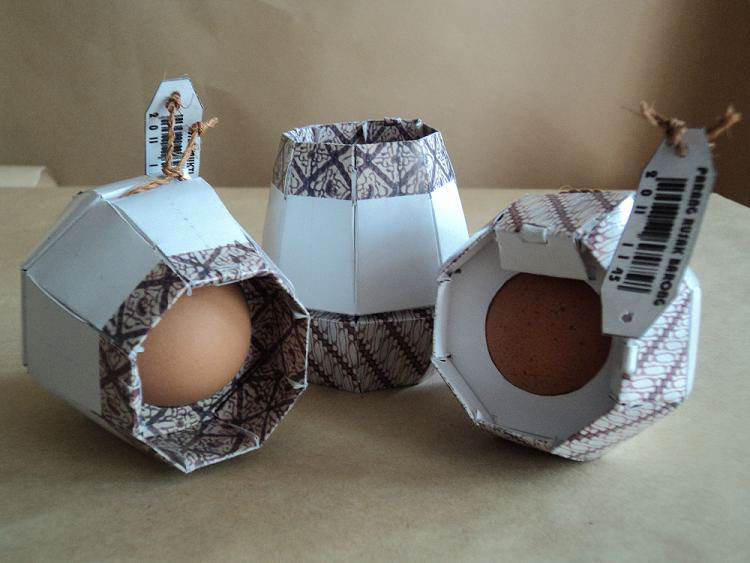KURUYUK
An egg packaging which ispackaging one by one of each eggs without gluing for each packages.
An egg packaging which ispackaging one by one of each eggs without gluing for each packages.
The name of ‘KURUYUK’ was inspired by how the Indonesian peoples spell of what their ears hear about the crowing ofchicken which is its sound familiar with ‘cock a doodle doo’ in another country. If it miss spell into ‘kruyuk’ then its sound remembering theIndonesian peoples about the rumbling sound when their stomach need to be filled immediately with something easy to be consumed such as an omelet made from fresh egg.
KURUYUKis an egg packaging which is packaging one by one of each eggs without gluing for each packages that allowing the people to decide a number of eggs which can be specified according of their needs without restricted by content capacity of its package. KURUYUK looks like an octagonal crystal that open into its ends both of top and bottom so peoples can see the egg at least a half of its condition to make sure that it is fine so they can buy it. Folded on to itsemphasis, KURUYUK is designed to be scraped easily just manual by hands so the egg can be practically used to be cooked.
KURUYUKis an egg packaging which is packaging one by one of each eggs without gluing for each packages that allowing the people to decide a number of eggs which can be specified according of their needs without restricted by content capacity of its package. KURUYUK looks like an octagonal crystal that open into its ends both of top and bottom so peoples can see the egg at least a half of its condition to make sure that it is fine so they can buy it. Folded on to itsemphasis, KURUYUK is designed to be scraped easily just manual by hands so the egg can be practically used to be cooked.



Byusing an approximation which is the result of the slice about two space (justlike in limit theory which was illustrated perfectly by a Greek philosophernamed Zeno with his famous paradox about the race competition of the great heroAchilles and a turtle which is surprisingly won by a turtle because of Zenoslices the line of the distance to be very little segments that approximated tozero. Shortly,, Zeno made Achilles seems to be left behind a turtle even he wasso close to a turtle.), impact of the collision to an egg can be reduced until0% from the worst probability that can be happened: the broken egg. But realitycan bites, even if this happens, the crack will follow the circle line whichwas produced by the slice between the space holder of the egg (that presentedby the package) with the egg volume so its broken will not scattered in anywhere,just in that circle line.
KURUYUKmade from white duplex or art board which has the thickness that equal with thecalendar paper so it can be possible to make a plus value from an expiredcalendar because its paper can be recycled as the material to be used for thepackage (with necessity adjustment in the ends both of the top and bottom side).KURUYUK has no need a glue for the making process so it can reduce the productioncost or the cost that had been used before for the gluing process can besubstituted as the pay of the labors which can be recruited for assembling thepackage. It means KURUYUK can also participate to reduce the number ofunemployment people especially in crowded population country such as Indonesia.
KURUYUKmade from white duplex or art board which has the thickness that equal with thecalendar paper so it can be possible to make a plus value from an expiredcalendar because its paper can be recycled as the material to be used for thepackage (with necessity adjustment in the ends both of the top and bottom side).KURUYUK has no need a glue for the making process so it can reduce the productioncost or the cost that had been used before for the gluing process can besubstituted as the pay of the labors which can be recruited for assembling thepackage. It means KURUYUK can also participate to reduce the number ofunemployment people especially in crowded population country such as Indonesia.

Inaddition, there is a different view from its main function as the eggpackaging, KURUYUK can be seen as a couple unique little mannequin that will beintroduce the culture in Indonesia through batik which is printed as the motiffor ‘blangkon’ and ‘jarik‘ that was seems to be worn to the package. ‘Blangkon’is used to be male headdress then ‘jarik’ is used to be female cloth and bothof them are usually used in traditional Java culture of society. So, theinternational public can also know the history of batik in its used to thetraditional culture in Indonesia. From its knowledge, they can be understandthat batik is purely come from Indonesia and its patent is belongs toIndonesia. Batik which was printed as the motif for ‘blangkon’ and ‘jarik’ forthe package is written onto the information tag so if they who have interestfor batik come to visit Indonesia, they only need is say about the name of themotif which was interested them to come from for batik so it simplify theseller to help them find the various of its similar motif. It will be more savetime and get more familiar with Indonesia. So, KURUYUK is not about just an eggpackage but still a package with Indonesia as the whole product itself.



